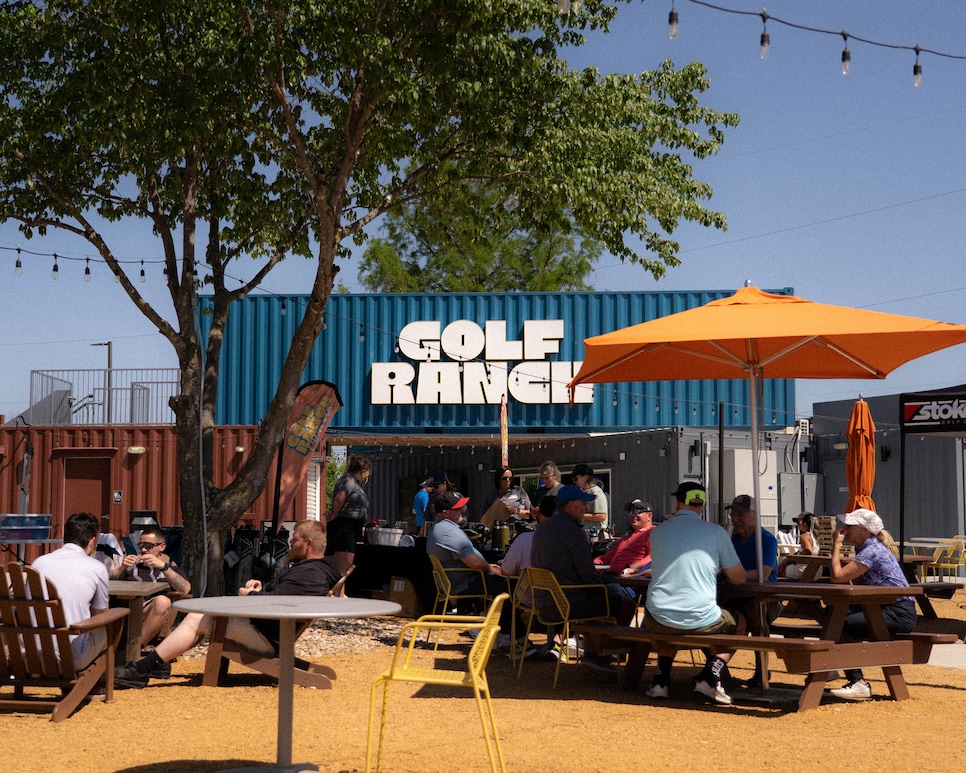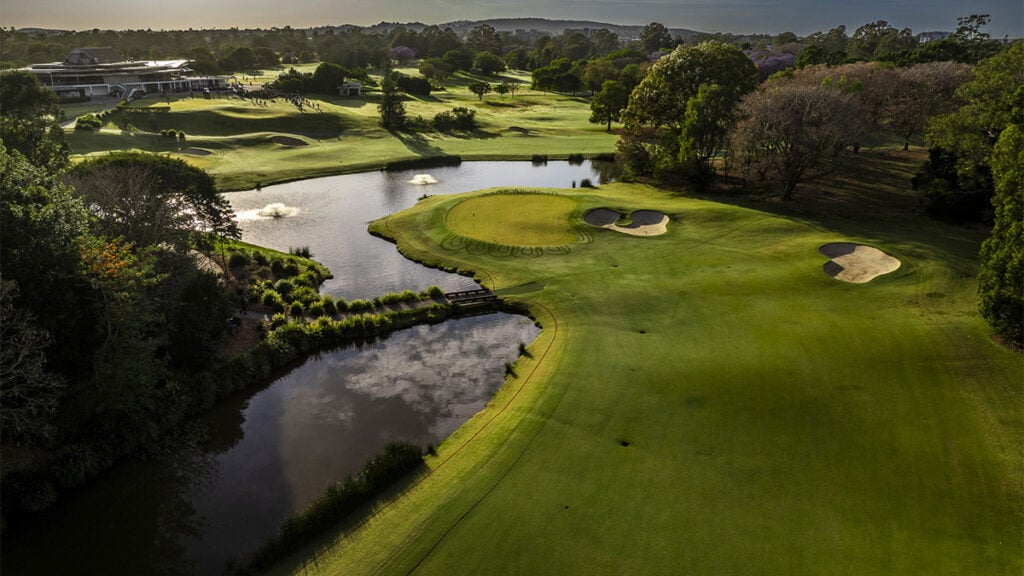In the more than six years he spent working on real estate development at Topgolf, Devin Charhon kept asking himself the same questions.
Is this a place where people come to practice and get better at the game? Are customers returning often? Do folks who go to Topgolf take the next logical step of heading out to the course?
As he and Michael Canfield, Topgolf’s former VP of Finance, sat in meeting after meeting, they realized that, despite spending millions to build these facilities, there was no real connection between the company and the customer. On average, people came to TopGolf less than twice a year. It was a great place to create awareness of golf for people who’d otherwise never pick up a club. But retaining those people, creating a community and a welcoming environment that they would want to return to multiple times a week was a challenge.
RELATED: Golf Digest’s Best Teachers In Every State (2026-’27)
For Charhon and Canfield, that’s when it clicked. The duo left Topgolf and started a company called Blue Jeans Golf, where their first idea was to address a gap in the market that exists somewhere between entertainment golf and green grass golf. They wanted to engage a segment of people who were looking to get into the game and actually get better, but without having to book a tee time and play 18 holes.
“The one key insight that I left Topgolf with was, ‘Hey, people love Topgolf. It’s an amazing sort of top-of-the-funnel experience to introduce people to the game,” said Charhon. “But people aren’t necessarily going back there frequently to practice and get better. It’s not a place for the core golfer. So that was kind of the thesis. This jump from entertainment golf to traditional golf is still a really big and intimidating one. How do we create the experience and the environment that should exist between those two ends of the spectrum? And how do we retain golfers?”
So, a driving range? Yes, sort of. But the regular ol’ public driving range hasn’t exactly evolved over the years. Go in, get your token, whack away. To bring in a younger demographic and keep them coming back, there needed to be something more than that.
Their idea was the Golf Ranch, a place that could seamlessly blend elements of the Topgolf experience like food and drink, Toptracer technology, music/vibes and nostalgic elements of the old-school driving range like bringing your own clubs, treating it as a legitimate practice session and simply hanging around as long as you’d like.
Rather than start from scratch, Charhon and Canfield decided to approach the owners of existing golf ranges, with existing customer bases, and sell them on a facelift of sorts. One key element of that facelift would be Toptracer technology, which is owned by Topgolf. Charhon had noticed the effect that was having on mom-and-pop ranges when Topgolf began offering the technology to ranges across the country back in 2018. That, plus features like a short-game area, a putting green and a place to sit down and have a few beers with friends were easy ways to revitalize the traditional range experience.

Matt Hahn
They were naturally met with some apprehension. Owners of these types of facilities tend to have owned them for a long time, so first there was the emotional attachment factor, as well as trepidation about what would happen to their business and to their employees.
“A big thing for us was building trust with these owners,” Charhon said. “And demonstrating our credibility and saying that we’re in the golf preservation business, right? We’re not a developer coming in, like an Amazon warehouse and saying, Hey, we want to turn your facility into a distribution center. We want to reinvest in the business that they’ve built and carry forward their legacy and continue operating golf. So I think that’s where it starts.”
RELATED: Do you need more speed to add 20 yards? Our robot test suggests otherwise
With the help of long-term equity and debt partners, the duo made their first purchase of a facility in Brookfield, Conn., in 2021, a range formerly known as Golf Quest. By October of 2023 they purchased three more locations, one in Richardson, Texas (formerly known as The Golf Ranch), and two in Missouri, one in Lee’s Summit (formerly known as Family Golf Park) and one in Kansas City (formerly known as Shoal Creek Driving Range). All four locations now have Toptracer, premium golf balls and mats to hit off and food and drink offerings. The Brookfield and Lee’s Summit locations also have mini golf courses, while the Kansas City location has batting cages.
The Richardson location, for now the crown jewel of the bunch, has a lighted par 3 course as well as heated bays for the winter months. It also has multiple chipping greens, a bunker area and extensive putting greens. Charhon and Canfield invested a few million into the project, helping not only keep the existing customers but bring in an entirely new audience. This has been huge for the prior owner, Steve Johnson, who remained on as an instructor and now has a host of new pupils looking for lessons.

Matt Hahn
Nik Bando, the Head of Media at Golf Ranch, tells a story of two of the Richardson location’s older longtime customers, Bill and Clyde. Both gentlemen were fearful of what was going to happen to their local range. Would it become overpriced and unrecognizable? An experience catered to a younger demographic that would be unwelcoming of two old guys just looking for a place to shoot the you-know-what for awhile? The Richardson Golf Ranch has been anything but. Bill and Clyde now come in five-to-six times per week to play on the par 3 or to roll some putts. Sometimes they just grab a coffee and people watch. It’s remained a home away from home.
“There’s like a nostalgic element to this, right?” says Bando. “Of like, hey, I have fun memories of going to the range with my dad and I remember sort of the simplicity of that experience, right? The experience of hitting golf balls and getting the ice cream cone afterward.
“I think some of these facilities, a lot of what we’ve come across, the experience isn’t that great anymore. So, for us, I think we view it as our chance to invest in these facilities that hold a special place in the community and bring them forward to meet the demands of the modern golfer. And I think that’s where we’ve got a lot of conviction now having operated four sites as well that hey, customers do want this. They want technology, they want high quality golf balls and they want high quality mats. They want an environment where they feel welcome and where they can be social. That’s what we believe we’re providing.”
Over the last year, at the three locations open in Brookfield, Richardson and Lee’s Summit, 22 million golf balls were hit. The Richardson Golf Ranch saw 100,000 golfers hit balls at the range, while Brookfield and Lee’s Summit each saw 60,000.
RELATED: 10 tips nobody tells you about becoming a scratch golfer
Perhaps the most important thing for customers, Bando says, is the service. They conducted a survey in 2024 and received 2,800 responses. One consistent theme they saw was that Golf Ranch-goers loved the Toptracer technology. Another theme was that they loved the friendliness of the staff. Each venue has between 25 and 50 employees that go through rigorous service training. Think more Chick-Fil-A drive thru employee and less short-tempered first-tee starter.
“To me, it’s the real secret sauce of our business,” said Bando. “This is supposed to be people’s happy place. When you get on site, it’s not soulless, scan my card at the ball machine and throw headphones on and don’t talk to anyone experience. It’s an environment that’s inherently social.”
Another key feature at all Golf Ranch locations is the ultimate traditional driving range feature. You purchase buckets of golf balls, not an allotted amount of time. No one will come up to remind you your hour is soon expiring, and you’ll need to make way for the next party. Your practice session begins and ends when you choose.
“This place is like Top Golf, but for golfers,” said a customer from the Richardson location. “Less of a party vibe, more of a relaxed practice vibe. It’s not stuffy like other golf courses. I feel welcome here as a beginner golfer.”

Within the next year, Charhon hopes to double the company, but to continue to do it in an intentional and methodical way. He and Canfield won’t simply be going around, buying up every old-school range in the country and slapping the Golf Ranch logo on them. It’s a process that is going to take time, by design.
“We’re not just spending money on new balls and mats and being like, hey, it’s the same as it was before, we’re just charging more,” Charhon said. “There’s way more that goes into it. We’re doing the investment on customer service, we’re trying to create meaningful communities. We believe in this ecosystem we can create around the range.”
On September 3, Blue Jeans Golf closed on the first round of its $20 million Series B funding, led by Old Tom Capital, an investment company that focuses on deploying capital across the golf industry, and Creator Sports Capital, an investment firm known for backing the popular content brand Good Good Golf. With the funding, Charhon and Canfield hope to expand to 10-to-12 locations by the end of 2026 and continue to build one of the largest driving range communities in the U.S., which already exceeds 8,000 active “Ranch Pass” members (the Ranch Pass is $20 a month and comes with numerous benefits designed at bringing customers back).
“We invest in brands that build undeniable communities. We saw it happen in the digital world with Good Good Golf, and now Golf Ranch is building the physical headquarters for that movement,” said Brian Kabot, Co-Managing Partner at Creator Sports Capital.
“They’ve cracked the code on a model that’s not only scalable and community-driven, but also makes the game more fun,” Kabot added. “We believe the intersection of content and community at physical locations is the future.”
Charhon and Canfield’s ultimate goal? To open 50 locations and achieve more than 100,000 members, which has become a realistic target with this recent investment.
Is it possible that one day, they might buy an open plot of land and build a Golf Ranch from scratch? Sure, but Charhon says for now they are focused on the existing ranges where there is an embedded demand that they feel they can give a lift to. They’ve done that so far at the first four Golf Ranch locations in Connecticut, Texas and Missouri. Perhaps that new-school, old-school experience is next coming to a golf range near you.
This article was originally published on golfdigest.com




